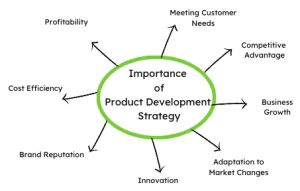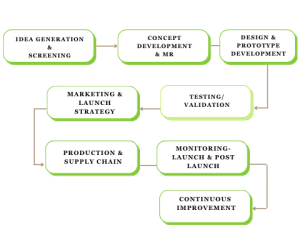A Detailed Guide to Product Development Strategy
A well-executed product development strategy combines creativity, market insight, and disciplined execution, resulting in products that delight customers and drive business growth.
Without a product development strategy, a company’s product lineup might become as exciting as a sandwich with no filling. This bland, predictable offering leaves customers feeling like they’ve stumbled upon a snooze fest instead of a shopping spree. So, let’s spice things up with a pinch of strategy and a dash of innovation!
Let us dive deep to know what is a product development strategy, why it is needed and how to make one for your brand.
What is product development strategy?
Product development strategy refers to a systematic approach employed by businesses to create and introduce new products or enhance existing ones.
- It involves various activities to understand customer needs, generate innovative ideas, design, prototype, test, refine, and finally launch the product.
- The primary objective of product development strategy is to create offerings that satisfy customer demands, gain a competitive advantage, and generate revenue for the business.
- It requires careful planning, market research, and a deep understanding of consumer preferences and trends.
Read: Best SEO Strategy to Rank# 1 in Google.
Key Elements of Product Development Strategy
Here are some key elements and considerations involved in product development strategy:
Idea Generation:
This stage involves brainstorming and gathering ideas for new products or improvements to existing ones. It can be driven by market research, customer feedback, technological advancements, or internal innovation initiatives.
Concept Development:
Ideas are evaluated and refined into viable concepts once generated. This involves considering feasibility, market potential, technical requirements, and profitability.
Market Research:
Understanding the target market is crucial for successful product development. Market research helps identify customer needs, preferences, and competitors, enabling businesses to create products that fulfil market demands effectively.
Design and Prototyping:
During this phase, product designs are created, and prototypes are developed to visualise and test the product’s functionality, aesthetics, and user experience. Iterative feedback and refinement help in fine-tuning the product design.
Testing and Validation:
Product prototypes undergo rigorous testing to meet quality standards and fulfil customer expectations. This can involve user testing, focus groups, and technical assessments to validate the product’s performance and address any issues.
Launch and Commercialization:
The product is ready for launch after successful testing and refinement. This involves planning the marketing and distribution strategies, pricing, and creating promotional campaigns to generate awareness and drive sales.
Continuous Improvement:
The product development strategy doesn’t end with the launch. It includes ongoing monitoring of customer feedback, market trends, and competitors’ actions to identify opportunities for product enhancements and updates. This iterative process helps maintain the product’s relevance and competitiveness.
Effective product development strategies align with business goals, market dynamics, and consumer needs. They require cross-functional collaboration, innovation-driven culture, and a commitment to delivering customer value.
Why Do You Need A Product Development Strategy?
Product development strategy is important because it helps to ensure that what you offer is valuable for the potential customers.
- It will keep up the demand of the product and enable you to provide the highest quality product to meet the market needs.
- The product development strategy plays a crucial role in the success of a business.
- It involves creating, designing, and launching new products or improving existing ones to meet customers’ evolving needs and preferences.
Here are some reasons why a strong product development strategy is essential:

Meeting customer needs:
In today’s dynamic market, customer preferences and demands constantly change.
- A well-defined product development strategy enables a company to stay ahead of the competition by identifying and fulfilling customer needs.
- By understanding consumer trends and conducting market research, businesses can develop products that address specific pain points, offer innovative solutions, and provide a superior customer experience.
Competitive advantage:
A robust product development strategy helps a company differentiate itself from competitors.
- A business can gain a competitive edge by continuously innovating and introducing new features, functionalities, or designs.
- A unique product offering attracts customers and increases market share and brand loyalty.
Business growth:
Launching new or enhancing existing products allows a company to expand its product portfolio and tap into new markets.
- A well-executed product development strategy can drive business growth by attracting new customers, increasing sales, and generating additional revenue streams.
- It also provides opportunities for upselling and cross-selling to existing customers, further bolstering the company’s financial performance.
Adaptation to market changes:
Markets are dynamic, and consumer preferences, technologies, and trends evolve over time.
- A product development strategy enables a business to adapt to these changes effectively.
- A company can continuously evaluate market dynamics, consumer feedback, and emerging technologies to update and refine its products to stay relevant and meet evolving customer expectations.
- This agility helps businesses remain competitive in an ever-changing business landscape.
Innovation and brand reputation:
A strong product development strategy fosters innovation within a company.
- It encourages a culture of creativity, experimentation, and problem-solving, which can lead to breakthrough products and technologies.
- A company can consistently introduce innovative products to enhance its brand reputation as an industry leader known for delivering cutting-edge solutions.
- A positive brand image contributes to customer trust, loyalty, and long-term success.
Cost efficiency and profitability:
While product development requires investments, a well-executed strategy can lead to cost efficiencies and improved profitability in the long run.
- By accurately identifying market gaps and consumer needs, companies can avoid costly product failures and minimise the risk of developing products that do not resonate with customers.
- Effective product development processes, such as prototyping and testing, can also reduce the chances of costly errors or rework, ultimately enhancing cost-effectiveness and profitability.
- A well-defined product development strategy is essential for a business’s sustained growth and success.
- It enables companies to meet customer needs, gain a competitive advantage, drive business growth, adapt to market changes, foster innovation, enhance brand reputation, and achieve cost efficiency.
- By prioritising product development, companies can stay relevant, capitalise on emerging opportunities, and build a strong foundation for long-term market success.
Brand Example of Product Development Strategy

One example of a brand that has successfully implemented a product development strategy is Apple Inc.
- Apple is known for its innovative and cutting-edge technology products that have transformed industries and captured the imagination of consumers worldwide.
- Apple’s product development strategy focuses on introducing new and improved versions of its existing products and introducing entirely new product categories. For example, the company regularly releases updated versions of its flagship products, such as the iPhone, iPad, and MacBook, incorporating new features, improved performance, and sleeker designs.
- These iterative improvements help Apple maintain its competitive edge in the market and retain customer loyalty.
- Apple engages in breakthrough product development, introducing entirely new products that disrupt existing markets.
- One notable example is the Apple Watch, which created a new wearable technology category. The Apple Watch combines advanced health and fitness tracking features with a sleek design, appealing to tech enthusiasts and fashion-conscious consumers.
- Apple’s product development strategy is driven by in-house research and development (R&D), strategic partnerships, and acquisitions. The company invests heavily in R&D to push the boundaries of technology and design, ensuring its products deliver unique and compelling experiences.
- Apple also collaborates with third-party developers and partners to create a vibrant ecosystem of apps and accessories that enhance the functionality and appeal of its products.
- Apple’s product development strategy closely aligns with its overall brand image and marketing efforts. The company emphasises the integration of hardware, software, and services, creating a seamless user experience across its product lineup. This cohesive approach differentiates Apple from its competitors and strengthens its brand identity.
Strategy for new product development-A complete guide
Developing a new product requires careful planning and execution. Here’s a complete guide to help you navigate the process of new product development:

Process: Develop a Product Strategy
Idea Generation:
- Start by brainstorming ideas for new products. Encourage creativity and consider customer needs, market trends, and technological advancements.
- Conduct market research to identify gaps in the market and understand customer preferences and pain points.
Idea Screening:
- Evaluate the feasibility and potential of each idea based on factors like market demand, competition, resources required, and profitability.
- Eliminate ideas that don’t align with your business goals or lack market potential.
Concept Development:
- Define the concept for the new product, including its features, benefits, target market, and unique selling proposition.
- Create preliminary sketches, diagrams, or prototypes to visualise the product.
Market Research:
- Conduct thorough market research to validate the concept and gather feedback from potential customers.
- Use surveys, focus groups, and interviews to understand customer preferences, expectations, and willingness to pay.
Product Design:
- Based on the concept and market research, develop a detailed product design that includes specifications, technical requirements, and aesthetic elements.
- Consider factors like functionality, usability, safety, and manufacturing feasibility.
Prototype Development:
- Build a prototype or a minimum viable product (MVP) to test and refine the design.
- Collect feedback from internal teams, partners, and select customers to identify areas for improvement.
Testing and Validation:
- Conduct rigorous testing to ensure the product meets quality standards and performs as expected.
- Perform alpha and beta testing with real users to gather feedback and uncover issues or usability challenges.
Marketing and Launch Strategy:
- Develop a comprehensive marketing strategy to create awareness and generate interest in the new product.
- Identify target customer segments, positioning, pricing, distribution channels, and promotional activities.
Production and Supply Chain:
- Set up the necessary production processes and supply chain management to ensure efficient manufacturing and timely delivery.
- Establish relationships with suppliers and manufacturers, ensuring quality control and cost optimization.
Launch and Post-Launch Monitoring:
- Execute the product launch according to the defined marketing strategy.
- Monitor customer feedback, sales performance, and market response closely after the launch.
- Make necessary adjustments to the product or marketing strategy based on real-world insights.
Continuous Improvement:
- Gather feedback from customers and internal stakeholders to identify areas for improvement.
- Use this feedback to enhance the product, address issues, and introduce new features or upgrades.
The new product development process is iterative and requires flexibility. Adapt your approach based on feedback and market dynamics to increase your chances of success.
Conclusion
A well-defined product development strategy helps businesses to align product development efforts with overall business goals, ensuring a focused and purposeful approach. It enables businesses to identify and capitalise on market opportunities, increasing customer satisfaction and market share.
It provides a structured framework for innovation, allowing businesses to consistently deliver successful products that meet customer needs. If you are looking forward to get assistance on developing, connect with us at hello[at]noboruworld.com
FAQ
What is product strategy?
Product strategy is a high-level plan that outlines the direction and goals for a company’s products or services. It involves decisions regarding the target market, value proposition, positioning, pricing, features, and differentiation. Product strategy aligns the product with the overall business objectives and helps guide its development, marketing, and growth.
Why is product strategy important?
Product strategy is important because it provides a roadmap for creating and delivering products that meet customer needs and achieve business goals. It helps businesses make informed decisions about which products to develop, how to differentiate them in the market, and how to prioritise resources and investments. A well-defined product strategy can increase customer satisfaction, market share, and profitability.
How does product strategy relate to overall business strategy?
Product strategy is a subset of the overall business strategy. While the business strategy sets the overall direction and goals of the company, the product strategy focuses specifically on the products or services offered by the business. The product strategy should align with and support the broader business objectives, market positioning, and customer value proposition.
How often should a product strategy be reviewed and updated?
The frequency of reviewing and updating a product strategy depends on various factors, such as the industry, market dynamics, and the lifecycle stage of the product.
Generally, reviewing the product strategy at least annually or whenever significant changes occur in the market, competition, or customer needs is recommended. Regular monitoring of key performance indicators (KPIs) can also trigger the need for strategy updates.
Also Read – A Guide to the Product Development Process (With Examples)



